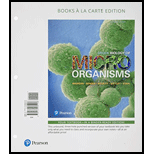
A medium was inoculated with 5 × 106 cells/ml of Escherichia coli cells. Following a 1-h lag, the population grew exponentially for 5 h, after which the population was 5.4 × 109 cells/ml. Calculate g and k for this growth experiment.
To calculate:
The generation time (g) and instantaneous growth rate constant (k) for the given growth experiment should be calculated.
Concept introduction:
The generation time is the specified time that requires to divide the cell into two. The bacteria reproduce by binary fission or cell division. The generation time depends on the environmental conditions such temperature, nutrients and pH and also it varies from one organism to the other organisms.
Explanation of Solution

The generation time (g) and instantaneous growth rate constant (k) for the given growth experiment is calculated below;

The generation time (g) and instantaneous growth rate constant (k) for the given growth experiment is calculated.
Want to see more full solutions like this?
Chapter 5 Solutions
Brock Biology of Microorganisms, Books a la Carte Plus Mastering Microbiology with Pearson eText -- Access Card Package (15th Edition)
- The bacterium Dontuplodemeus tocheggus has a generation time of 20 minutes. Starting with one cell in 500 mL of culture medium, how many minutes would it take to reach a cell density of approximately one million cells per mL? Assume all cells remain viable. a. 330 b. 660 c. 380 d. 400 e. 580arrow_forwardpropose a hypothesis regarding the organisms (staphylococcus, escherichia, pseudomonas, and bacillus) that will be resistant to the most disinfectants, and why? if the hypothesis is supported, what specific experimental results will be observed? what would be the independent and dependent variable? zone size, disinfectant type, colony countarrow_forwardIn growing E.coli, why is that (reasons) they do not grow after doubling time under 20 degrees celsius and under 37 degrees celsius, the number of colonies after doubling time has decreased? provide reliable sources (links).arrow_forward
- Are you able to identify the lag, log, stationary and death phase in using these growth curves?Are you able to calculate the generation time for this microbe under the two conditions?arrow_forwardDesign a serial dilution procedure to achieve a 56-colony count, from a sample with 8.75x105 CFU/mL bacterial concentration.arrow_forwardA species of bacteria has a doubling time of 24 hours. After incubating the initial population for one week, the final population was 6,400 cells. What was the initial population of that bacteria? Show all work. Equations: Nt = No x 2n Final concentration = (initial concentration)/(total dilution factor) Total dilution factor = (individual dilution factor)# of serial dilutionsarrow_forward
- I have a culture containing 106 organisms/ml and need to dilute it to 1000 organisms/ ml. Can you draw out a serial dilution diagram that I could follow to reach 1000 organisms/ ml If I plate 150ul of the final diultion onto YPD media, how many colonies approx would be expected on the plate?arrow_forwardIf in 5 hours, your bacterial culture went from a concentration of ~105 CFU/mL to ~1.6 x 106 CFU/mL, what is the best estimate of the doubling time of that species in those culture conditions (based on these numbers)? A. ~1 hour B. ~75 minutes C. ~150 minutes D. ~8 hours E. ~2 hoursarrow_forwardIf the generation time is 90 min and the initial population contains 103 cells, how many bacteria will there be after 8 hours of exponential growth?arrow_forward
- A 0.00001 dilution is performed on a culture of bacteria in order to perform viable plate counts. From the dilution, *0.1 mL* of solution is plated on solid media, and 223 colonies of bacteria grow on the petri dish. Assuming each colony came from a single bacterium, how many bacteria are in a single mL of the original culture? Express your answer to two decimal places using exponential notation. Since only 0.1 mL is put on the plate, this counts as an extra dilution!!! Any time less than 1 mL is transfered, a dilution is being performed. Any time more than 1 mL is transfered, a concentration is being performed.arrow_forwardStrain X. spp. is a rod-shaped, anaerobic, Gram-positive bacterium with peritrichous flagella andpili that could use glucose and dye as its sole carbon source. Answer the following sections (a, band c).a) With a doubling time of 240 minutes and a starting population size of 10 bacteria cells. Howmany bacteria cells will be present after 72 hours, assuming no cell death?b) Draw the diagram and describe motility required for the bacteria to gradient concentrationof attractant (food)?arrow_forwardBelow is a set of data for a serial dilution/plate count experiment. Based on this data what is the calculated concentration of bacteria in CFU/mL in the original culture? The OD600 of a bacterial culture that's been diluted in half is 0.842. What is the estimated population of cells in the original undiluted culture? asaparrow_forward
 Human Anatomy & Physiology (11th Edition)BiologyISBN:9780134580999Author:Elaine N. Marieb, Katja N. HoehnPublisher:PEARSON
Human Anatomy & Physiology (11th Edition)BiologyISBN:9780134580999Author:Elaine N. Marieb, Katja N. HoehnPublisher:PEARSON Biology 2eBiologyISBN:9781947172517Author:Matthew Douglas, Jung Choi, Mary Ann ClarkPublisher:OpenStax
Biology 2eBiologyISBN:9781947172517Author:Matthew Douglas, Jung Choi, Mary Ann ClarkPublisher:OpenStax Anatomy & PhysiologyBiologyISBN:9781259398629Author:McKinley, Michael P., O'loughlin, Valerie Dean, Bidle, Theresa StouterPublisher:Mcgraw Hill Education,
Anatomy & PhysiologyBiologyISBN:9781259398629Author:McKinley, Michael P., O'loughlin, Valerie Dean, Bidle, Theresa StouterPublisher:Mcgraw Hill Education, Molecular Biology of the Cell (Sixth Edition)BiologyISBN:9780815344322Author:Bruce Alberts, Alexander D. Johnson, Julian Lewis, David Morgan, Martin Raff, Keith Roberts, Peter WalterPublisher:W. W. Norton & Company
Molecular Biology of the Cell (Sixth Edition)BiologyISBN:9780815344322Author:Bruce Alberts, Alexander D. Johnson, Julian Lewis, David Morgan, Martin Raff, Keith Roberts, Peter WalterPublisher:W. W. Norton & Company Laboratory Manual For Human Anatomy & PhysiologyBiologyISBN:9781260159363Author:Martin, Terry R., Prentice-craver, CynthiaPublisher:McGraw-Hill Publishing Co.
Laboratory Manual For Human Anatomy & PhysiologyBiologyISBN:9781260159363Author:Martin, Terry R., Prentice-craver, CynthiaPublisher:McGraw-Hill Publishing Co. Inquiry Into Life (16th Edition)BiologyISBN:9781260231700Author:Sylvia S. Mader, Michael WindelspechtPublisher:McGraw Hill Education
Inquiry Into Life (16th Edition)BiologyISBN:9781260231700Author:Sylvia S. Mader, Michael WindelspechtPublisher:McGraw Hill Education





